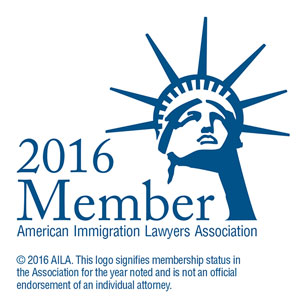The False Distinction Between Legal and Undocumented Immigrants in the Debate on Birthright Citizenship
By Cyrus D. Mehta and Kaitlyn Box*
Donald Trump’s executive order restricting birthright citizenship, which we analyzed in a previous blog, has now been temporarily enjoined and is the subject of multiple lawsuits. The executive order has also brought to light the false dichotomy between “legal” and “undocumented” immigrants, obscuring the nuance of U.S. immigration laws. [Although the Trump administration has replaced references to undocumented individuals with the term “illegal”, we use “undocumented” here to refer to individuals who currently have no legal immigration status in the U.S.]
“Legal” and “undocumented” immigrants alike are subject to the jurisdiction of the United States pursuant to the 14th Amendment. The concept of jus soli, enshrined in the 14th Amendment, has long guaranteed children born in the U.S. the right to U.S. citizenship, regardless of the immigration status of their parents. The Trump administration is incorrectly asserting in its executive order that the 14th Amendment was never intended to confer birthright citizenship to parents who are not lawfully in the US or to parents who may be lawfully in the US but on temporary visas. Many people participating in the debate on social media feel that birthright citizenship should only be conferred by parents who are legally in the US, and if a tweak has to be made in Trump’s executive order, it should only remove the restrictions on parents who are legally in the US but on temporary visas. The executive order is unconstitutional in its entirety and should be struck down.
This distinction between “legal” and “undocumented” immigrants is an overly simplistic, and often false, one. A noncitizen who entered the U.S. with a valid visa can easily fall out of status, while a path to U.S. citizenship may eventually become available to an individual who was previously undocumented. Indeed, legal and “undocumented” immigration are points on a continuum rather than discrete concepts. An entirely undocumented individual who is placed in removal proceedings can seek cancellation of removal and become a permanent resident. Similarly, an individual who entered the U.S. on a nonimmigrant visa and overstayed it for many years could meet and marry a U.S. citizen spouse, thus becoming eligible to apply for permanent residence. At times, Congress bestows such permanent residency to previously-undocumented individuals through section 245(i) or the LIFE Act.
Moreover, one thinks of an undocumented immigrant as a person who entered the United States without inspection or who came to the US legally on a visa and overstayed. However, the term is broader to encompass persons who were previously unauthorized and who have been authorized to stay such as recipients of the Deferred Action of Childhood Arrivals (DACA) program, applicants for Temporary Protected Status (TPS), those who have pending asylum applications and applications for other relief such as under the Violence Against Women Act (VAWA) or crime victim U visas. There are also those who are on supervised release or who have obtained stays of removal and eligible for employment authorization year after year.
In 1982 in Plyler v. Doe, 457 US 202 (1982), a landmark Supreme Court case which held children could not be deprived of a public education on the basis of their immigration status, the Court eloquently explained that an individual’s undocumented status is often temporary, stating:
To be sure, like all persons who have entered the United States unlawfully, these children are subject to deportation. But there is no assurance that a child subject to deportation will ever be deported. An illegal entrant might be granted federal permission to continue to reside in the country, or even become a citizen.
The Court affirmed that an undocumented individual living in the United States “is surely ‘a person’ in any ordinary sense of that term,” “[w]hatever his status under the immigration laws.” Plyler v. Doe, 457 U.S. 202, 210 (1982).
Moreover, some individuals who do currently have a lawful status may nonetheless be authorized to remain in the U.S., as we highlighted in another prior blog. An asylum applicant is authorized to remain in the U.S. and apply for employment authorization 150 days after filing the asylum application even though he has not yet been granted asylum and would not qualify as an asylee under 8 CFR 245.1(d)(1)(iii). Similarly, an individual who has filed an I-485 application to adjust status is authorized to remain in the U.S. even if she does not have a valid, underlying nonimmigrant status. An individual in removal proceedings is authorized to remain in the U.S. and seek relief until the conclusion of the proceedings. Even a noncitizen who has been ordered removed but filed petition for review in circuit court can apply for work authorization and continue to reside in the U.S. during the pendency of the appeal.
In Arizona v. United States, 567 U.S. 387 (2012), the Supreme Court emphasized the importance of discretion in removal proceedings, explaining that it is not always appropriate to place even an entirely undocumented individual in removal proceedings:
Congress has specified which aliens may be removed from the United States and the procedures for doing so. Aliens may be removed if they were inadmissible at the time of entry, have been convicted of certain crimes, or meet other criteria set by federal law. See §1227…A principal feature of the removal system is the broad discretion exercised by immigration officials…Federal officials, as an initial matter, must decide whether it makes sense to pursue removal at all…
Discretion in the enforcement of immigration law embraces immediate human concerns. Unauthorized workers trying to support their families, for example, likely pose less danger than alien smugglers or aliens who commit a serious crime. The equities of an individual case may turn on many factors, including whether the alien has children born in the United States, long ties to the community, or a record of distinguished military service. Some discretionary decisions involve policy choices that bear on this Nation’s international relations. Returning an alien to his own country may be deemed inappropriate even where he has committed a removable offense or fails to meet the criteria for admission. The foreign state may be mired in civil war, complicit in political persecution, or enduring conditions that create a real risk that the alien or his family will be harmed upon return. The dynamic nature of relations with other countries requires the Executive Branch to ensure that enforcement policies are consistent with this Nation’s foreign policy with respect to these and other realities.
Drawing a distinction between those on temporary visas and those who are lawful permanent residents also ignores the practical reality that many nonimmigrants are “Americans in waiting”. A nonimmigrant in H-1B status has a clear path to becoming a permanent resident, and eventually a U.S. citizen, through sponsorship by an employer but has to wait for many decades due to backlogs in their green card category. DACA recipients who have lived almost their entire lives in the U.S. may have few ties to any other country and could become lawful permanent residents through marriage to a U.S. citizen or LPR spouse, or through an employment-based category.
On the other hand, a noncitizen who comes to the United States with a valid visa may not could later overstay their visa, thus becoming “undocumented”. Violations of a nonimmigrant visa also render a noncitizen’s immigration status ambiguous. An H-1B worker who works from home and moves across the country before an amended H-1B petition is filed, for example, could technically be in violation of his status.
According to Professor Gerald Neuman, “[T]he framers of the Fourteenth Amendment had strong reason from desiring a constitutional settlement of the issue of birthright citizenship. They had just overthrown a system founded on denial of political membership in the country to a hereditary category of inhabitants. The Citizenship Clause was designed to prevent the situation from happening again…[T]he supporters of the Citizenship Clause expressly confirmed their intent to protect the children of Chinese parents by recognizing them as citizens.” See Statement of Prof. Gerald E. Neuman, Societal and Legal Issues Surrounding Children Born in the United States to Illegal Alien Parents: Joint Hearing Before the Subcomm. on Immigration & Claims and the Subcomm. on the Constitution of the H. Comm. on the Judiciary, 104th Cong. (1995).
The only exceptions were children born to diplomats of foreign nations who were not subject to the jurisdiction of the United States as well as children born to parents accompanying an invading army that temporarily ousted the operation of local law. The framers also excluded children born within Native American tribes because they owed allegiance to their tribal nations rather than the United States, but this preclusion was eventually eliminated by the Indian Citizenship Act of 1924.
On the other hand, undocumented parents are clearly subject to prosecution in the United States as well as temporary noncitizens. They can also hardly be considered to be part of an invading army that has ousted the local operation of law. Even the argument that undocumented parents and nonimmigrants owe their allegiance to a foreign government rather than to the U.S. government is spurious. Temporary residents in nonimmigrant status can remain in the U.S. for many years as they wait for permanent residence. They could owe allegiance to the U.S. government and so could an undocumented immigrant just as a U.S. citizen would. Lawful permanent residents, who are not U.S. citizens, could owe their allegiance to the U.S. government but also to a foreign government without risking losing that status. U.S. citizens may also be citizens of other countries and may owe their allegiance to a foreign government, the U.S. government, or both, but both U.S. citizens and lawful permanent residents qualify under Trump’s executive order to confer birthright citizenship to their children born in the U.S.
In United States v. Wong Kim Ark, 169 U.S. 649 (1898), the Supreme Court extended the Fourteenth Amendment to an individual who was born to parents of Chinese descent and during a time when Chinese nationals were subjected to the Chinese exclusion laws. The principle established in Wong Kim Ark applies with equal vigor today. Excluding an allegedly undocumented parent who has been a DACA recipient since 2012 from conferring birthright citizenship to their child would make no sense. It would also make no sense to deem a parent who was in technical violation of their H-1B status as undocumented at the time of the birth to her child. It would also be unfair to deprive a parent in lawful H-1B status who has been waiting for their green card for over a decade from conferring birthright citizenship to their child. The Supreme Court’s hallowed ruling on birthright citizenship established well over 125 years back a fundamental American value that all people born in the United States are equal at birth, regardless of their race, religion, or the immigration or financial status of their parents.
*Kaitlyn Box is a Partner at Cyrus D. Mehta & Partners PLLC.





Leave a Reply
Want to join the discussion?Feel free to contribute!